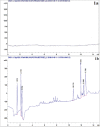Toxicological studies and bioactivity-guided identification of antimicrobially active compounds from crude aqueous stem bark extract of Boswellia dalzielii
- PMID: 31453189
- PMCID: PMC6702886
- DOI: 10.5455/javar.2019.f330
Toxicological studies and bioactivity-guided identification of antimicrobially active compounds from crude aqueous stem bark extract of Boswellia dalzielii
Abstract
Objective: The main objective of this study is to isolate, identify, and quantify the active antimicrobial compounds present in the crude aqueous stem bark extract of B. dalzielii using some common pathogenic microorganisms as well as toxicological profile.
Material and methods: Crude aqueous stem bark extract of Boswellia dalzielii (CASEB) was partitioned by preparative thin layer chromatography (PTLC) using chloroform-methanol-water, 8:2:1 (v/v). The resulting bands were extracted using chloroform-methanol (50:50). The extract of each band was evaluated for antimicrobial activity on Streptococcus pyogenes, Staphylococcus aureus, Escherichia coli, Enterococcus faecalis, Klebsiella pneumonia, Pseudomonas aeruginosa, Proteus mirabilis, Salmonella typhi, and Candida albicans by disc diffusion. Compounds in the most antimicrobially bioactive fraction (MAAF) were identified by high performance liquid chromatography (HPLC), Fourier transform infrared spectrophotometry (FT-IR), and gas chromatography-mass spectrometry (GC-MS). Toxicological profile of the CASEB was evaluated by studying its effect in albino Wister rats.
Results: PTLC produced five bands/fractions of which the MAAF was identified as RF2-fraction being active against all the isolates except E. coli and K. pneumoniae. HPLC of the MAAF revealed seven components; FT-IR revealed 17 functional groups; GC-MS revealed five compounds of which 93.18% are Oleic acid (44.88%), Squalene (34.16%), and n-Hexadecanoic acid (14.14%). The acute toxicity showed LD50 > 3,000 mg/kg. Sub-chronic toxicity showed that higher doses of the CASEB caused significant changes in liver function indices and a fatty change with lymphocytic infiltration (sign of acute hepatitis) in the liver tissues, but none of these changes were observed in the kidneys.
Conclusion: The antimicrobially active compounds in CASEB were Oleic acid, Squalene, and n-Hexadecanoic acid. These can be further purified and used as precursors of new antimicrobial agents for treating infections especially those due to fungi and Pseudomonas spp. that are known to resist wide array of antimicrobial agents. The LD50 of CASEB is >3,000 mg/kg in rats. However, long-term consumption of CASEB is associated with significant liver damage.
Keywords: Antimicrobial; Boswellia dalzielii; GC-MS; HPLC; bioactivity; chromatography; spectrophotometry; subchronic toxicity.
Conflict of interest statement
The authors declared no conflict of interest.
Figures




References
-
- Amudha P, Prabakaran R, Senthil KS, Gopinath LR. Phytochemical analysis of Albizia chinensis (Osbeck) merr medicinal plant. IOSR J Pharm Biol Sci. 2017;12:89–92.
-
- Ekor M. The growing use of herbal medicines: issues relating to adverse reactions and challenges in monitoring safety. Front Pharmacol. 2014;4:177. https://doi.org/10.3389/fphar.2013.00177. - PMC - PubMed
-
- Piao G, Haidan Y, Qianqian M, Li Y. The traditional medicine and modern medicine from natural products. Molecules. 2016;21(559):1–18. https://doi.org/10.3390/molecules21050559. - PMC - PubMed
-
- Ramesh L, Londonkar UMK, Kirankumar S, Rathee D, Deepti R, Permender R, et al. Phytochemical screening and antimicrobial activity of Picrorrhiza kurroa, an Indian traditional plant used to treat chronic diarrhea. Arab J Chem. 2012;9(Suppl 2):S1307–13. https://doi.org/10.1016/j.arabjc.2012.02.009.
-
- Rathee D, Rathee P, Rathee S, Rathee D. Phytochemical screening and antimicrobial activity of Picrorrhiza kurroa, an Indian traditional plant used to treat chronic diarrhea. Arab J Chem. 2016;9(Suppl 2):S1307–313. https://doi.org/10.1016/j.arabjc.2012.02.009.
LinkOut - more resources
Full Text Sources
Research Materials
Miscellaneous
